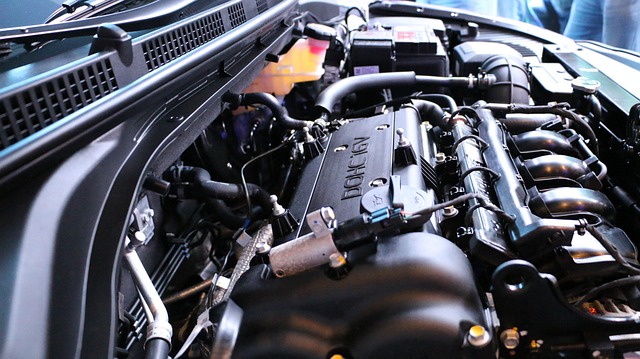Looking to register your car in California? This comprehensive guide walks you through the entire process, from understanding eligibility requirements to completing the DMV VIN verification. We’ll break down gathering essential documents, preparing your vehicle for inspection, and transferring titles. By the end, you’ll be ready to tackle the step-by-step registration process, ensuring a smooth ride on California’s roads. Key terms: dmv vin verification.
- Understand Eligibility Requirements for Car Registration in California
- Gather Necessary Documents for DMV VIN Verification
- Prepare Your Vehicle for Inspection and Title Transfer
- Complete the DMV Registration Process: Step-by-Step Guide
- Post-Registration Steps: Important Considerations for California Drivers
Understand Eligibility Requirements for Car Registration in California

Before diving into the registration process, it’s crucial to understand the eligibility requirements for car registration in California. To register your vehicle, you’ll need to meet specific criteria set by the Department of Motor Vehicles (DMV). One key step is ensuring your car has passed a safe and legal inspection, which often involves a DMV VIN verification. This process checks vital information about your vehicle, including its historical maintenance records and if it complies with California’s safety standards.
Additionally, you’ll require several essential documents, such as proof of ownership (a title or bill of sale), valid insurance, and identification. If you’re using a mobile vin verifier or undergoing a mobile vin inspection, ensure the service is reputable and authorized by the DMV to avoid any potential issues.
Gather Necessary Documents for DMV VIN Verification

Before you can register your car in California, you’ll need to ensure that all required documents are ready for the DMV VIN verification process. This includes gathering essential paperwork like your vehicle’s registration certificate from the previous state, proof of insurance, and a valid driver’s license or state-issued ID card. Additionally, you’ll require the Vehicle Identification Number (VIN) from your car, which can typically be found on a plate attached to the dashboard near the driver’s side door or in the engine compartment.
For a more convenient and efficient dmv vin verification, consider obtaining a mobile vin inspection or using a mobile vin verifier. These services allow you to have the VIN checked remotely, saving you time and effort. Just make sure that the verifier is reputable and accepted by the California DMV to avoid any issues during the registration process.
Prepare Your Vehicle for Inspection and Title Transfer

Before you can register your car in California, ensure your vehicle is ready for inspection by preparing essential documents and ensuring it meets all legal standards. The first step involves verifying the Vehicle Identification Number (VIN) to establish its authenticity and history. This process, known as DMV VIN verification, is crucial to prevent fraud and ensure compliance with state regulations. You can conduct this check through a mobile vin verifier or by visiting your local California Department of Motor Vehicles (DMV) office.
During preparation, gather all necessary paperwork, including the title, registration documents, and proof of insurance. Additionally, consider scheduling a mobile vin inspection if you have any concerns about the vehicle’s history or want a hassle-free alternative to visiting the DMV in person. This convenience allows for quicker verification, especially for busy individuals with demanding schedules.
Complete the DMV Registration Process: Step-by-Step Guide

To complete the DMV registration process for your car in California, follow these straightforward steps. First, gather all necessary documents, including your vehicle’s registration certificate from the previous state, proof of insurance, and a valid driver’s license. Then, visit a California Department of Motor Vehicles (DMV) office or use their online services to initiate the registration.
Next, perform a DMV vin verification by providing your Vehicle Identification Number (VIN). This step ensures the vehicle’s history is checked for any issues. You can do this in-person or, conveniently, opt for a mobile VIN inspection service that allows you to verify the VIN digitally, saving time and effort. Once the VIN verification is complete, review and accept the vehicle’s details on the registration form. Pay the required fees, and your car will be officially registered with the California DMV.
Post-Registration Steps: Important Considerations for California Drivers

After successfully registering your vehicle with the California Department of Motor Vehicles (DMV), there are several crucial post-registration steps to ensure a smooth ownership experience. One essential consideration is completing a DMV VIN verification, which confirms the vehicle’s identity and history. This process involves cross-referencing the Vehicle Identification Number (VIN) with national databases to uncover any potential issues or discrepancies.
Additionally, California drivers should familiarize themselves with local regulations regarding registration renewals, title transfers, and insurance requirements. Utilizing a mobile VIN verifier can streamline this process by providing instant access to vehicle history reports, including details about previous owners, maintenance records, and any reported accidents. This added layer of due diligence ensures that both you and the DMV have accurate information, fostering a safer and more accountable driving environment.
Registering a car in California is a straightforward process, but understanding the requirements and gathering the necessary documents is crucial. From ensuring your vehicle meets safety standards to completing the DMV VIN verification, each step contributes to a smooth registration experience. By following our comprehensive guide, from preparing your vehicle to post-registration considerations, you’ll be well on your way to becoming a California driver with a valid car registration in no time.
